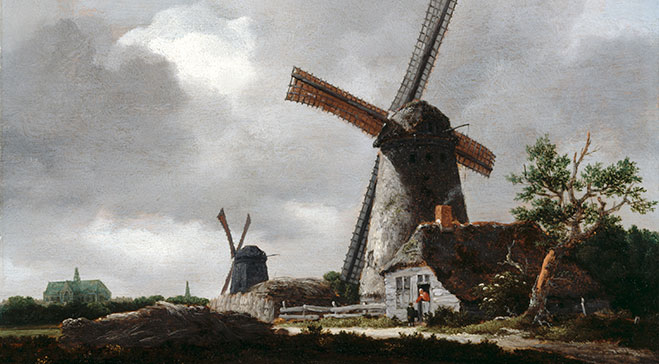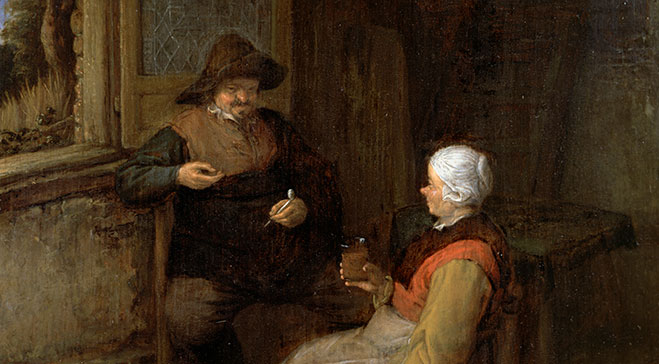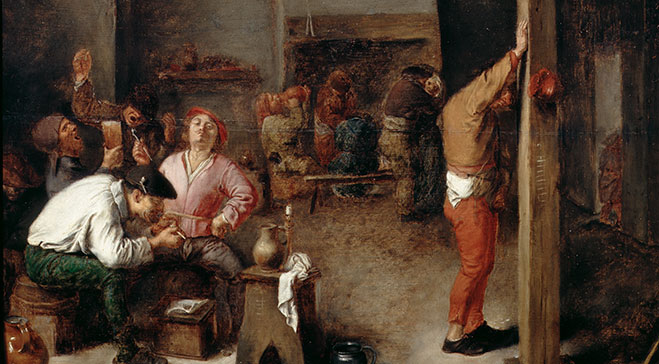Unlocking the Dutch Golden Age
Helen Record, our Curatorial Intern, talks us through the latest developments in our Unlocking Paintings project and illuminates a period in history that shaped a key part of our collection, the Dutch Golden Age.
Paintings are on the move at Dulwich. Last year we celebrated 200 years since first opening our doors to the public and, moving forwards, we want to ensure that our works of art are as enjoyable and relatable to our visitors today as they were in 1817. This has formed the basis of a project called ‘Unlocking Paintings’ which will explore new and different ways of looking at works in the collection to bring them to life for our audiences in the 21st century.
One of the first parts of Unlocking Paintings has been our rehang of Gallery 10 – with its sunshine yellow walls, you really can’t miss it! Walk into the Gallery and you will find yourself swept into the Netherlands in the 17th century, to the height of the Dutch Golden Age. At this time, the Dutch Republic was one of the wealthiest parts of Europe, with booming trade and industry leading to advancements in the arts and technology. The paintings hanging in this Gallery reflect the dynamism and variety of the art of the Dutch Republic. The recent independence from Catholic Spain in the late 16th century had given the Dutch population new confidence and enthusiasm. The wealth of the rapidly expanding merchant class, the burghers, meant that demand for goods and personal possessions was greater than ever before. Art became particularly desirable, leading to an explosion of the art market. The range of paintings hanging in the Gallery reflects the diverse demands for art: landscapes, seascapes, interior scenes of everyday life, portraits, still life.
The title of the display in Gallery 10 – ‘Rembrandt’s Truth’ – highlights how artists working in the Dutch Republic found new ways to portray the world around them in a highly realistic, evocative manner, producing paintings that seem like snapshots of Dutch society. In some cases however, painters included an element of artistic license to add to the dramatic, visual or emotional impact of their paintings. The new arrangement of paintings in Gallery 10 attempts to give a cross-section of the art world in the Dutch Golden Age, providing an insight into a society where works of art were no longer just for the traditional elite – royalty, the aristocracy, and the Church – but for ordinary citizens, who collected according to personal tastes and budget. Many of the paintings on display are much smaller than those hanging in other sections of the Gallery (French, Spanish, Italian, for example), and depict everyday, recognisable scenes such as tavern interiors, rural landscapes or vases of flowers. Both the small size and the apparently mundane subject matter reveal that these paintings were personal possessions of the middle classes, decorating domestic walls and depicting familiar sights.
Jacob van Ruisdael’s Landscape with Windmills Near Haarlem (c.1650-2) [detail at top of page], for example, shows a seemingly unremarkable part of the Dutch countryside, dominated by two towering windmills. These were a common sight in the Dutch Republic. Whilst to our 21st-century eyes, windmills may seem outdated and nostalgic, to a Dutch burgher they were a symbol of cutting-edge technology and the key to Dutch economic power. Ruisdael does not merely paint the countryside as it appeared at the time, however. The view itself is only loosely based on reality, with Ruisdael adjusting the composition to add to the theatricality of the scene. He also exaggerates certain features such as the imposing windmills and heavy clouds by adopting a low vantage point and using broad, animated brushstrokes. Ruisdael breathes life into the painting, using artistic skill to create a false reality. This relatively small painting was exactly the sort that wealthy merchants would have hung in their own homes – looking at it today allows us to step through their front door and be a guest to their world.
The small Interior of a Cottage (c.1670s) by Adriaen van Ostade [detail above] presents us with a man and a woman sitting in a simple, sparsely decorated room. They are engaged in conversation; she holds a cup and a jug, swinging by her side, whilst he gesticulates and grips his smoking pipe. Like Ruisdael’s Landscape with Windmills, this paintings provides a window into the spirit of the Dutch Republic. It is a gentle depiction of a familiar scene, showing people of humble means. Yet this shows an idealised view of peasant life, a vision of harmony and civility despite modest or even impoverished circumstances. Scenes of this kind were extremely fashionable amongst merchant classes, showing the poetic beauty of the peasant classes. This small work is one of many that Ostade – and many other painters – produced showing peasants in various situations, at rest, working, arguing, playing – drinking. Adriaen Brouwer’s Interior of a Tavern (c.1630) [detail above] shows us possible consequences of precisely this last activity. Plunged into a dingy room in an inn, we are surrounded by rowdy peasants who have had a few too many. Some swig straight from the jug or smoke pipes, others laugh and shout, and one notable fellow relieves himself in a corner. The scene certainly raises a smile (and an eyebrow) and maybe even some pangs of empathy when we look at it today. In the 17th century, however, it was also meant to teach a lesson. Paintings like this used humour bordering on caricature to show the lower classes at their most outrageous. They acted as a powerful reminder of the dangers of excess and improper behaviour for the self-respecting Dutch citizens who chose to hang them in their homes.
The three paintings discussed here – Ruisdael’s Landscape, Ostade’s Interior of a Cottage, and Brouwer’s Interior of a Tavern – give a flavour of the new display in Gallery 10. This first set of paintings that we have brought together in our Unlocking Paintings project gives an insight into 17th-century Dutch society. The realistic style of painting brings the Dutch Golden Age to life, but also reveals how artists used their imagination and skill to heighten the impact of their works. We hope that the range of genres and subject matters capture the vibrancy of the art market in the Dutch Republic in the 17th century, giving a snapshot of a society with its own material desires, social expectations and fashionable tastes – not that dissimilar from our own world in the 21st century. The stories behind the paintings allow us to see past what is before us to a world beyond, making connections with the individuals who produced, purchased, and marvelled at these paintings much like we can today. By Unlocking Paintings, we can show that the past is not such a foreign place after all.
Discover more about our Unlocking Paintings project, and how you can help us achieve it >>



